Diffuse Knapweed
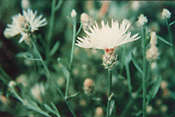 Diffuse Knapweed is a biennial single-stemmed plant with numerous lateral branches. Flowers are white to rose, or occasionally purplish. The flower heads are slender with pointed, fringed bracts.
Diffuse Knapweed is a biennial single-stemmed plant with numerous lateral branches. Flowers are white to rose, or occasionally purplish. The flower heads are slender with pointed, fringed bracts.
Diffuse Knapweed will form dense stands on any open ground, excluding
more desirable forage species. Once established, the necessary
extensive control measures are often more expensive than the potential
income of the land.
Test plots by the OSU Extension Service have shown that residual chemicals are preferable when trying to control the weed. Picloram (Tordon 22K), dicamba (Banvel), 2,4-D LV and Amine are effective. Always read and follow the label. Biological controls are increasing, check with local weed control personnel for more information.
Weed Inspector Home
Leafy Spurge
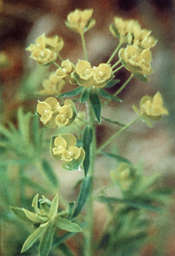 Leafy
Leafy
Spurge is a perennial with flowers borne in an umbel and are surrounded
by yellowish-green bracts. These bracts turn yellow in late May, making
them easier to identify. The plant has an extensive root system.
Leafy Spurge can reduce the cattle carrying capacity of rangelands by
50 to 75 percent. Once it is established, it requires an extensive
program to eradicate.
Research at North Dakota State University shows a cost-effective option is a combination of picloram (Tordon 22K) and 2,4-D. In sensitive areas, use dicamba (Banvel) or glyphosate (Roundup). In all cases, repeat applications on an annual or semi-annual basis for three to five years. Always read and follow the label.
Weed Inspector Home
Rush Skeletonweed
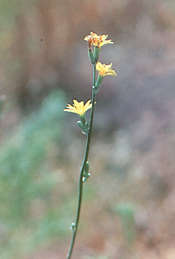 Rush
Rush
Skeletonweed is a perennial which flowers July through September. It
can be identified by the yellow flowers, about 3/4-inch in diameter with
seven to 15 petals and coarse downbent hairs on the lower 4 to 6 inches
of the stem. The plant is 1 to 4 feet tall with almost no leaves.
An aggressive plant in both rangeland and cropland, particularly in
light texture soils, extensive efforts have been made to eradicate Rush
Skeletonweed, but new sites are being found each year in Eastern Oregon
and Malheur County.
The plant can be controlled with high rates of picloram (Tordon 22K);
followup treatment will be necessary for two or three years, and
sometimes longer. Pulling the plant is not recommended, nor is
cultivating through live roots. Small root segments can establish
additional plants. Always read and follow the label on chemical
treatments.
If you find a plant fitting this descriptions, mark the location and contact your State Agricultural Department, or County Weed Control Department before taking any steps to destroy the plant.
Weed Inspector Home
Spotted Knapweed
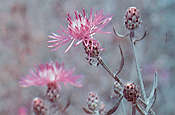 (Centaurea maculosa) is a biennial or short-lived perennial. A multi-stemmed plant with several stems arising from the crown, flowers are light purple to violet, or occasionally cream colored. The tips of the flower head bracts are black, making the seed head appear spotted. The flower head is slender, about 1/2 inch long and urn shaped which is typical of most Centaurea species. Each seed head can produce hundreds of seeds each. Develops a slender taproot reaching as deep as 2 feet in ideal conditions. Spotted Knapweed
(Centaurea maculosa) is a biennial or short-lived perennial. A multi-stemmed plant with several stems arising from the crown, flowers are light purple to violet, or occasionally cream colored. The tips of the flower head bracts are black, making the seed head appear spotted. The flower head is slender, about 1/2 inch long and urn shaped which is typical of most Centaurea species. Each seed head can produce hundreds of seeds each. Develops a slender taproot reaching as deep as 2 feet in ideal conditions. Spotted Knapweed
Spotted Knapweed will form dense stands on any open ground, excluding
more desirable forage species. This plant prefers moister conditions
than Diffuse knapweed, but can survive at fairly dry sites, also tends
to choose gravelly to sandy areas. Once established, the necessary
extensive control measures are often more expensive than the potential
income of the land.
This species is relatively easy to control with herbicides. All phenoxy type products, (2,4-D, Tryclopr, Dicamba) all work well. Test plots by the OSU Extension Service have shown that residual chemicals are preferable when trying to control the weed. Picloram (Tordon 22K), dicamba (Banvel), 2,4-D LV and Amine are effective. Always read and follow the label. Biological controls are increasing, check with local weed control personnel for more information.
Weed Inspector Home
Yellow Starthistle
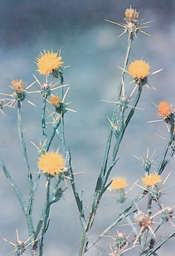 Yellow starthistle is usually a winter annual germinating in the fall but can also have early spring germinates. The plant has yellow flowers from an urn shaped seed head typical of the aster family, with long sharp stiff spines at the end of its bracts. Some seeds have parachute hairs and some don’t, resulting in a distribution that produces dense stands and rapid spreading. The plant is toxic to horses causing chewing disease which is irreversible and always fatal.
Yellow starthistle is usually a winter annual germinating in the fall but can also have early spring germinates. The plant has yellow flowers from an urn shaped seed head typical of the aster family, with long sharp stiff spines at the end of its bracts. Some seeds have parachute hairs and some don’t, resulting in a distribution that produces dense stands and rapid spreading. The plant is toxic to horses causing chewing disease which is irreversible and always fatal.
Yellow starthistle is an aggressive, adaptable weed that inhibits the
growth of desirable plants in pasture, rangelands and waste land. It
can become a problem in CRP ground where the grass stand is weak. The
plant has been found in wheat crops where waste lands are heavily
infested.
Residual chemicals are preferred for control, due to the long germination period. Picloram (Tordon 22K), dicamba (Banvel), and 2,4-D LV and Amine are effective. Always read and follow the label. Biological controls may be available for sites with sufficient plant densities. Fortunately Malheur County has had limited outbreaks which have all been contained, however rapid response is essential.
